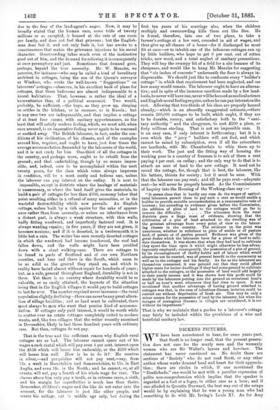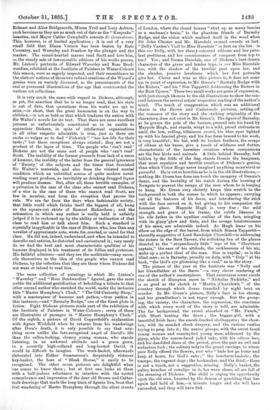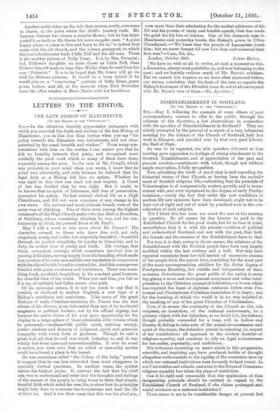DICKENS PICTURES.
WE have been accustomed to hear, for some years past, that Scott is no longer read, that the present genera- tion does not care for the manly men and the womanly women who are Sir Walter's heroes and heroines. The statement has never convinced us. No doubt there are sections of 'Society' who do not read Scott, or any other author whose works demand head and heart for their apprecia- tion; there are circles in which, if one mentioned the " Desdichado," one would be met with a peculiar expression of polite non-comprehension which implies that the speaker is regarded as a fool or a fogey, in either case as a bore; and if one alluded to Quentin Durward, the best way out of the scrape would be by explaining that he was a young man who had something to do with Mr. Irving's Louis XI. As for Amy
Robsart and Alice Bridgenorth, Minna Troil and Lucy Ashton, such heroines as they are as mach out of date as the "Keepsake" beauties, and Major Calder Campbell's sonnets de circonetane,e. This, however, is of limited application ; it is out of a very small field that Diana Vernon has been beaten by Kate Coventry, and Waverley and Ivanhoe by the plunger and the masher. The sound-hearted masses read Scott and love him, as the steady sale of innumerable editions of his works proves. Mr. Linton's portraits of Edward Waverley and Rose Brad- vrardine, exhibited at the Institute of Painters in Water-Colours this season, were as eagerly inspected, and their resemblance to the visitors' notions of those two refined creations of the Wizard's genius were as warmly discussed, as the presentments of the real or presumed illustrations of the age that overcrowded the various art collections.
It is very much the same with regard to Dickens, although, as yet, the assertion that he is no longer read, that his style is out of date, that quotations from his works are apt to tniss,—in short, that the great humourist is on the way to oblivion,—is not so bold as that which traduces the nation with Sir Walter's novels for its text. That there are some excellent persons so unfortunately constituted as to be unable to appreciate Dickens, in spite of intellectual organisations in all other respects admirable, is true, just as there are snobs so vulgar as to find " Pickwick " "too low-life for their taste ;" but these exceptions always existed ; they are not a product of the lapse of time. The people who can't read' Dickens are not the same sort of people who can't read' Scott. The inability of the former proceeds from lack of a sense of humour, the inability of the latter from the general ignorance of l Society' of the subjects and the times that furnished Sir Walter's materials, and also from the vitiated mental condition which an unbridled course of quite modern novel. reading must produce, as inevitably as drinking drugged liquor will produce disease. But, after all, these terrible examples, of a privation in the case of the class who cannot read Dickens, of a vice in the case of those who cannot read Scott, are few in number, and form the exception that proves the rule. We are far from the days when fashionable society, that little world which thinks itself the biggest of all, hung on the square-cut skirts of Samuel Richardson ; and the estimation in which any author is really held is unfairly judged if it be reckoned up by the ability or inclination of that class to read him or talk about him. Such a standard is -especially inapplicable in the case of Dickens, who, less than any novelist of approximate note, wrote for, courted, or cared for that class. He did not, indeed, understand, and when he intended to describe and satirise, he distorted and caricatured it ; very rarely do we find the best and most characteristic qualities of his humour displayed in his treatment of its follies and pretences. His faithful admirers—and they are the multitude—may recon- cile themselves to the idea of the people who cannot read Dickens, by the reflection that they are those whom Dickens did not want or intend to read him.
The same collection of paintings in which Mr. Linton's Waverley" and "Rose Bradwardine " figured, gave the mere public the additional gratification of beholding a tribute to that other unread author who enriched the world, under the inclusive title "Master Humphrey's Clock," "The Old Curiosity Shop," with a masterpiece of humour and pathos,—true pathos in this instance,—and "Barnaby Rudge," one of the finest plots in fiction. Eight Dickens pictures made part of the exhibition of the Institute of Painters in Water-Colours ; seven of these are illustrative of passages in "Master Humphrey's Clock." Of the eighth, a picture of David Copperfield's explanation with Agnes Wickfield when he returns from his wanderings after Dora's death, it is only possible to say that any- thing more unlike the late-recognised angel of David's life than the sullen-looking, clumsy young woman, who stands listening, in an awkward attitude and a green gown, to a correctly high-collared and long-booted David, it would be difficult to imagine. The work-basket, afterwards elaborated into Esther Summerson's desperately virtuous key-basket, the bore of "Bleak House," is easily to be recognised. The other seven pictures are delightful when one comes to know them ; but at first one looks at them with a half-jealous reluctance to interfere with the rooted remembrance and impression of the dear old Brown and Catter- mole drawings that made the long train of figures live, from that first wandering of Master Humphrey through the silent streets
of London, where the closed houses "shut up as many fancies as a madman's brain," to the phantom friends of Barnaby Rudge, and the vision which realised itself in the wood when Sir John Chester and Mr. Haredale crossed swords at last. "Dolly Varden's Visit to Miss Haredale" is first on the list : is this our Dolly, with her cherry-coloured ribbons and her petu- lant prettiness, and her consciousness of conquest from top to toe ? Yes ; and Emma Haredale, one of Dickens's best-drawn characters of the grave and tender type, is our Miss Haredale too, with the shadow of the terrible past upon her, and the slender, pensive loveliness which her first portraits give her. Clever and true as this picture is, it does not come up, in point of expression, to Mr. Green's "Barnaby Radge with the Rioters," and his "Sim Tappertit Addressing the Rioters in the Boot Tavern." These two small works are gems of expression, with just enough likeness to the old illustrations to show the con- cord between the several artists' respective reading of the author's mind. The touch of exaggeration which was an additional charm in the Brown and Cattermole pictures, setting-off the romance of the story and the striking originality of the characters, does not exist in Mr. Green's. The figure of Barnaby, as he grasps the pole of the banner, pressed into his hand by Maypole Hugh, and stands, wrapt in a wild, proud enthusiasm amid the low, yelling, villainous crowd, his blue eyes lighted up with his fancied glory, and his fine form braced to his work, is very beautiful ; his hat, with its broken feathers, the scraps of ribbon at his knees, give a touch of wildness and flutter, characteristic of the harmless creature whose companions are the free birds and animals. A little behind Barnaby, half hidden by the folds of the flag, stands Dennis the hangman, that most repulsive and terrible creation of Dickens's genius, than which Victor Hugo never imagined anything more:vivid or powerful. He is not so horrible as he is in the old illustrations,— nothing Mr. Green has done can touch the savagery of Dennis's dance, and the brutality of his watch during the burning of Newgate to prevent the escape of the men whom he is longing to hang. Mr. Green very cleverly keeps this wretch in the background in both the scenes in which be appears ; carrying out all the features of his dress, and introducing the stick with the face carved on it, but giving to his companion the foremost place. Maypole Hugh is very fine ; the wild strength and grace of his frame, the subtle likeness to his vile father in the aquiline outline of the face, mingling with its gipsy-glow and tints, and the savage boisterousness of his mien, are admirable indeed. As Hugh leans on his elbow on the edge of the barrel, from which Simon Tappertit- absurdly suggestive of Lord Randolph Churchill—is addressing the rioters in the Boot Tavern, the rollicking fun of the glance directed to the "stupendously little" legs of his "illustrious captain," the ease of his attitude, the recklessness of his air, make up a perfect ideal of the man. Sim is capital ; so is the blind man ; so is Barnaby, proudly on duty, with " Grip " at his back, "the bird's eye glistening like a coal," as in the story.
The picture of the year at the Institute was " Nelly and her Grandfather at the Races "—a very clever rendering of one of the author's masterpieces. That racecourse scene excels the sketch of Hampton races in "Nicholas Nickleby," and is as good as the sketch in "Martin ;Chuzzlewit " of the country through which Jonas travelled by night bent on murder. In Mr. Green's picture, Nelly's face is too strong, and her grandfather's is not vague enough. But the group- ing, the variety, the characters, the expression,: the exactness with which every word of the story is told, are admirable. The far background, the crowd absorbed in "Mr. Punch," with Short beating the drum ; the beggar-girl, with a beautiful Irish face; the smock-frocked clodhoppers ; the show- box, with its mended cheek drapery, and the curious rustics trying to peep into it ; the nearer groups, with the sweet.faced young woman and countryfied young man, addressed by the gipsy, while the coarse-faced jaded rake, with his odious leer, and his dandified dress of the period, gives the pair an evil and audacious look ; the solitary lady in the grand carriage, to whom poor Nelly offered the flowers, and who "bade her go home and keep at home, for God's sake ;" the luncheon-baskets; the tramps; the vagrant dogs ; the bookmaker, and the thief,—there is not a touch, not a suggestion, missing. Nelly's basket, the paltry bunches of cowslips in it, her worn shoes, all are full of the meaning of Dickens. The child is urging the opportunity upon the old man, haunted by the demon of gambling that has again laid hold of him,—a minute longer and she will have succeeded, and they will have fled.
Another artist takes up the tale that cannot, surely, ever cease to charm, at the point where the child's journey ends. Mr. Lawson Stewart has chosen a simpler theme; but he has inter, pret,ed it as truly as Mr. Green his more complex ones. "A quiet, happy place—a place to live and learn to die in," is indeed that scene with the old -church, and the solemn graveyard, to which . the poor schoolmaster leads Little Nell and the old man. Thew is yet another picture of Nelly Trent. It is by Mvs. Perugini ; but Dickens's daughter no more shows us Little Nell, than. Dickens himself•made us hear Sam Weller when he read from his own "Pickwick." It is to be hoped that Mr. Green wilL go on with his Dickens pictures. It would be a boon indeed if ha would give us a " convincing " portrait of Sally Brass, green gown, button, and all, at the moment when Dick Swiveller dusts the office window in Bevis Marks with her headdress.








































 Previous page
Previous page